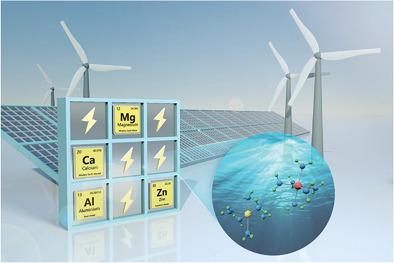当前位置:
X-MOL 学术
›
Adv. Funct. Mater.
›
论文详情
Our official English website, www.x-mol.net, welcomes your
feedback! (Note: you will need to create a separate account there.)
Cathode Design for Aqueous Rechargeable Multivalent Ion Batteries: Challenges and Opportunities
Advanced Functional Materials ( IF 18.5 ) Pub Date : 2021-01-20 , DOI: 10.1002/adfm.202010445 Yiyang Liu 1, 2 , Guanjie He 1, 2, 3 , Hao Jiang 4 , Ivan P. Parkin 2 , Paul R. Shearing 1, 5 , Dan J. L. Brett 1, 5
Advanced Functional Materials ( IF 18.5 ) Pub Date : 2021-01-20 , DOI: 10.1002/adfm.202010445 Yiyang Liu 1, 2 , Guanjie He 1, 2, 3 , Hao Jiang 4 , Ivan P. Parkin 2 , Paul R. Shearing 1, 5 , Dan J. L. Brett 1, 5
Affiliation

|
With the rapid growth in energy consumption, renewable energy is a promising solution. However, renewable energy (e.g., wind, solar, and tidal) is discontinuous and irregular by nature, which poses new challenges to the new generation of large‐scale energy storage devices. Rechargeable batteries using aqueous electrolyte and multivalent ion charge are considered more suitable candidates compared to lithium‐ion and lead‐acid batteries, owing to their low cost, ease of manufacture, good safety, and environmentally benign characteristics. However, some substantial challenges hinder the development of aqueous rechargeable multivalent ion batteries (AMVIBs), including the narrow stable electrochemical window of water (≈1.23 V), sluggish ion diffusion kinetics, and stability issues of electrode materials. To address these challenges, a range of encouraging strategies has been developed in recent years, in the aspects of electrolyte optimization, material structure engineering and theoretical investigations. To inspire new research directions, this review focuses on the latest advances in cathode materials for aqueous batteries based on the multivalent ions (Zn2+, Mg2+, Ca2+, Al3+), their common challenges, and promising strategies for improvement. In addition, further suggestions for development directions and a comparison of the different AMVIBs are covered.
中文翻译:

水性可充电多价离子电池的阴极设计:挑战和机遇
随着能源消耗的快速增长,可再生能源是一个有前途的解决方案。但是,可再生能源(例如风能,太阳能和潮汐能)在本质上是不连续且不规则的,这给新一代大型储能设备带来了新的挑战。与锂离子和铅酸电池相比,使用含水电解质和多价离子电荷的可充电电池被认为是更合适的选择,因为它们的成本低,易于制造,安全性好以及对环境无害。但是,一些重大挑战阻碍了水性可充电多价离子电池(AMVIB)的开发,包括水的稳定电化学窗口窄(约1.23 V),缓慢的离子扩散动力学以及电极材料的稳定性问题。为了应对这些挑战,近年来,在电解质优化,材料结构工程和理论研究等方面,已经开发出了一系列令人鼓舞的策略。为了激发新的研究方向,本综述着重于基于多价离子(Zn)的水性电池正极材料的最新进展。2+,Mg 2 +,Ca 2 +,Al 3+),它们的共同挑战和有希望的改进策略。此外,还涵盖了有关发展方向的进一步建议以及不同AMVIB的比较。
更新日期:2021-03-24
中文翻译:

水性可充电多价离子电池的阴极设计:挑战和机遇
随着能源消耗的快速增长,可再生能源是一个有前途的解决方案。但是,可再生能源(例如风能,太阳能和潮汐能)在本质上是不连续且不规则的,这给新一代大型储能设备带来了新的挑战。与锂离子和铅酸电池相比,使用含水电解质和多价离子电荷的可充电电池被认为是更合适的选择,因为它们的成本低,易于制造,安全性好以及对环境无害。但是,一些重大挑战阻碍了水性可充电多价离子电池(AMVIB)的开发,包括水的稳定电化学窗口窄(约1.23 V),缓慢的离子扩散动力学以及电极材料的稳定性问题。为了应对这些挑战,近年来,在电解质优化,材料结构工程和理论研究等方面,已经开发出了一系列令人鼓舞的策略。为了激发新的研究方向,本综述着重于基于多价离子(Zn)的水性电池正极材料的最新进展。2+,Mg 2 +,Ca 2 +,Al 3+),它们的共同挑战和有希望的改进策略。此外,还涵盖了有关发展方向的进一步建议以及不同AMVIB的比较。


















































 京公网安备 11010802027423号
京公网安备 11010802027423号